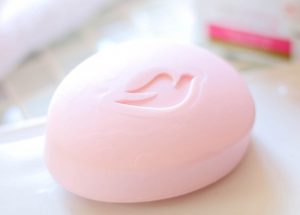 Dove launched their “Campaign for Real Beauty” in 2004.
Dove launched their “Campaign for Real Beauty” in 2004.
Instead of ads full of models and celebrities, they featured “real women”.
These ads were made to make women identify with the models instead of envy them,
and make them feel more connected to the brand.
Dove has marketed themselves as a “pure” brand, above the rest of the drugstore brands in both product quality and mission.
While the mission part is commendable, Dove’s ingredients are no better and sometimes worse,
than any other drugstore brand of beauty products.
Dove products to avoid
Let’s take a look at some of the most popular Dove beauty products to see how pure they really are.
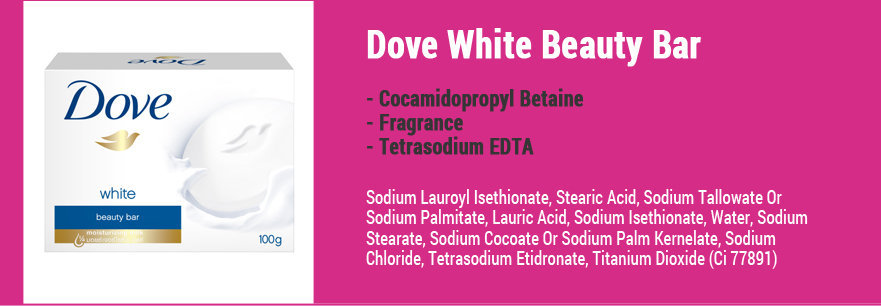 Dove White Beauty Bar
Dove White Beauty Bar
The longest-running Dove product, it was introduced to the market in the 1950s.
Since then Dove has stuck to the same marketing, touting that the bar has “1/4 moisturizer” and “won’t dry out your skin like other soap”.
While that may be true, this beauty bar still contains ingredients that are suspicious or downright dangerous for your health.
Ingredients: Sodium Lauroyl Isethionate, Stearic Acid, Sodium Tallowate Or Sodium Palmitate,
Lauric Acid, Sodium Isethionate, Water, Sodium Stearate, Cocamidopropyl Betaine,
Sodium Cocoate Or Sodium Palm Kernelate, Fragrance, Sodium Chloride, Tetrasodium EDTA, Tetrasodium Etidronate, Titanium Dioxide (Ci 77891)
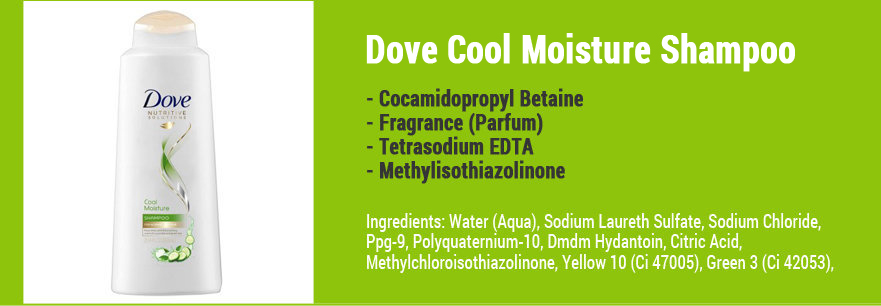 Dove Cool Moisture Shampoo
Dove Cool Moisture Shampoo
Dove’s basic shampoo is supposed to be protective and nourishing for your hair.
It claims that your hair will be “up to 5X smoother” by using it.
By including harmful preservatives, fragrance, and color, this shampoo is not doing your hair any favors.
Ingredients: Water (Aqua), Sodium Laureth Sulfate, Cocamidopropyl Betaine, Sodium Chloride,
Fragrance (Parfum), Ppg-9, Polyquaternium-10, Tetrasodium Edta, Dmdm Hydantoin, Citric Acid,
Methylchloroisothiazolinone, Methylisothiazolinone, Yellow 10 (Ci 47005), Green 3 (Ci 42053),
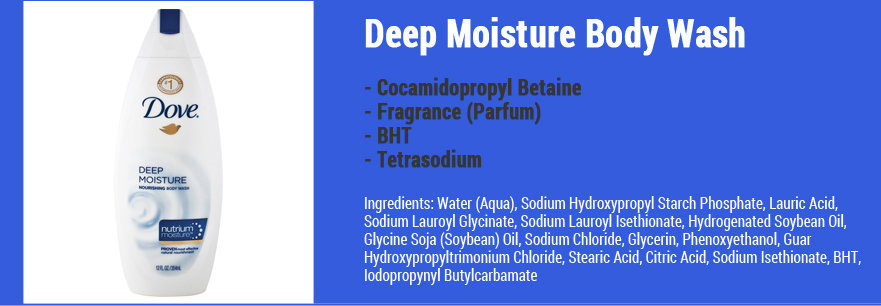 Deep Moisture Body Wash
Deep Moisture Body Wash
This body wash is marketed as nourishing and long-lasting, and it claims to “deliver natural nutrients to the skin”.
Dove also claims that it’s #1 dermatologist recommended.
Take a look at this ingredient list and think about rubbing it on your body every day.
Ingredients: Water (Aqua), Cocamidopropyl Betaine, Sodium Hydroxypropyl Starch Phosphate,
Lauric Acid, Sodium Lauroyl Glycinate, Sodium Lauroyl Isethionate, Hydrogenated Soybean Oil,
Glycine Soja (Soybean) Oil, Sodium Chloride, Glycerin, Fragrance (Parfum), Phenoxyethanol,
Guar Hydroxypropyltrimonium Chloride, Stearic Acid, Citric Acid, Sodium Isethionate, BHT, Tetrasodium, Iodopropynyl Butylcarbamate
 Dove Advanced Care Original Clean Antiperspirant
Dove Advanced Care Original Clean Antiperspirant
This antiperspirant claims to contain ¼ moisturizer like the beauty bar,
and says that it gives “up to 48-hour antiperspirant protection”.
Antiperspirants, in general, are harmful to your health, but Dove’s has some truly scary ingredients.
Ingredients: Active Aluminum Zirconium Tetrachlorohydrex Gly (15.2%). Purpose: Anti-Perspirant.
Inactive Cyclopentasiloxane, Stearyl Alcohol, C12-15 Alkyl Benzoate, Ppg-14 Butyl Ether, Hydrogenated Castor Oil,
Peg-8, Fragrance (Parfum), Dimethicone, Silica, Polyethylene, Helianthus Annuus (Sunflower) Seed Oil, Steareth-100, Bht, Hydroxyethyl Urea.
Why these ingredients are dangerous?
Now we’ll take a closer look at some of those tongue-twisting ingredients and see why they’re dangerous for you.
Cocamidopropyl Betaine
Cocamidopropyl Betaine is a surfactant, a chemical that makes things bubble and suds.
In particular, this one has been linked to allergic reactions, contact dermatitis, and skin and eye irritation.
It can also contain many impurities like nitrosamines, which have a strong connection to cancer growth.
Methylisothiazolinone
This one is a preservative, used so the other ingredients don’t spoil.
It is also used as a pesticide and fungicide.
The European Union (EU), Canada, Germany, and Japan have all banned its use because of evidence that it is neurotoxic, or poisonous to your brain.
The US Environmental Protection Agency (EPA) has declared it to be “highly acutely toxic” and corrosive when it comes in contact with eyes or skin.
The majority of Dove products in the USA still use this ingredient.
Aluminum Zirconium Tetrachlorohydrex Gly
This compound is the active ingredient in antiperspirants.
If you don’t already know how antiperspirant works, when you apply it to your underarms it is absorbed into your skin.
The chemicals in the product are then activated to block your sweat glands and stop you from sweating.
Sweating is one way your body gets rid of toxins.
By clogging your sweat glands your body cannot get rid of these dangerous waste products and they end up circulating through your body more and more.
Aluminum is the most common antiperspirant (literally: stop perspiring/sweating), and studies are showing that it causes unbelievable harm to your body.
Aluminum in the body has been linked to breast cancer growth, increase in allergic reactions, and neurological disorders.
Fragrance/Parfum
Fragrance in any item is a really sneaky way that manufacturers expose you to harmful chemicals.
There are no regulations on what can be used, and companies don’t have to disclose the ingredients of their fragrance.
However, some chemicals that are very common in fragrances have big consequences for your well-being.
Artificial musks are linked to hormone disruption.
Phthalates are used to keep plastics soft as well as add fragrance and are extremely easy for your body to absorb.
Many fragrances cause allergic rashes and breathing problems, as well as headaches and nausea.
Tetrasodium EDTA
This one is scary for two reasons. First is what it does, and second is what it’s made of.
Tetrasodium EDTA is a penetration enhancer, which is a cleaned-up way of saying it breaks down the protective layer of your skin so other ingredients can be absorbed deeply and quickly.
It is formulated from formaldehyde, a known poison and preservative generally used to keep dead bodies from decaying too quickly.
Formaldehyde is also linked to skin rashes, eye, nose, and throat irritation, and causes some types of cancers.
BHT
BHT stands for Butylated Hydroxytoluene. It is a synthetic preservative used in many beauty products and cosmetics, as well as in food.
Animal tests done on BHT exposure showed that it interrupted blood coagulation, decreased lung functions, and damaged the liver, kidneys, and thyroid.
It was also shown to promote tumor growth and disrupt the reproductive hormones in the body.
Take a moment to think about the myriad of different health and beauty products you use every day.
You probably start by washing your hair and body in the shower and then use antiperspirant as you get dressed for the day.
How many times a day do you wash your hands? Imagine putting these toxic compounds on your body 10 or 20 times over the course of the day.
Dove wants you to buy their products so you can love who you are, but judging from the ingredients listed above, Dove definitely doesn’t love you back.
To protect yourself from these toxic chemicals (which lead to higher risk of cancer) in many of our everyday’s products, go to the next page and discover how to boost your immune system –
About the Author:
Emma Deangela is the best selling author of The Alkaline Diet Program and 80/20 Fat Loss. She has helped over tens of thousands of men and women to lose weight and transform their health with sound nutrition advice. Learn how you can lose weight fast – How to lose weight by adding these alkaline foods.
Do you use any of the Dove products?
Please share with your friends this article on Dove Products – Use any of the social media and email buttons on the left of our website.
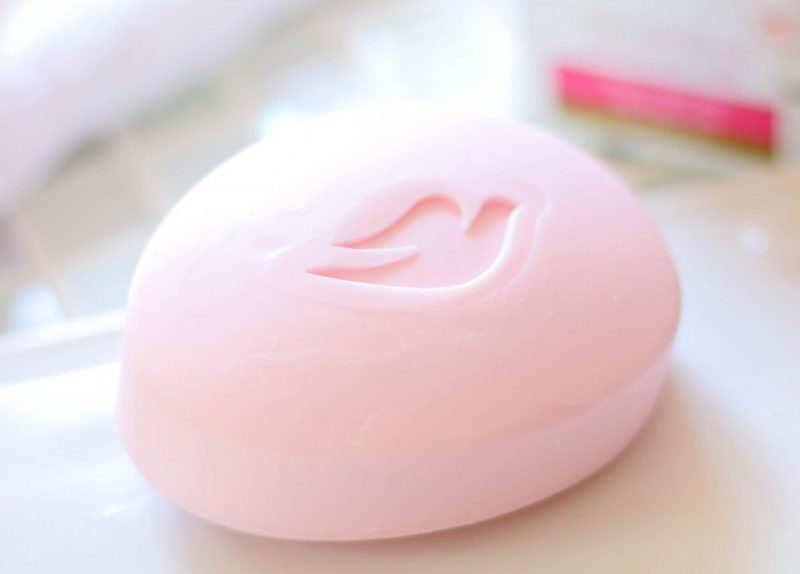

Leave a Reply